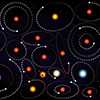| Oct 23, 2023 |
|
|
|
(Nanowerk News) In a new study published in the Astronomical Journal (“Developing a Drift Rate Distribution for Technosignature Searches of Exoplanets”), researchers used the known population of exoplanets and extrapolated to the much larger, unknown population of exoplanets to set better thresholds for planetary effects on signals from ETIs (extraterrestrial intelligences). The prior recommendation for the threshold “drift rate” contribution, caused by a planet’s motion around its host star, was 200 nHz.
|
|
In this work, lead author Megan Grace Li and her team found that 53 nHz was sufficient in 99% of known-exoplanet cases and that this value drops to a mere 0.44 nHz for stars without known planets. These significant, data-driven reductions in the recommended drift rate threshold will lead to considerable savings in computing time and, therefore, boosted efficiency for future SETI (Search for Extraterrestrial Intelligence) campaigns.
|
 |
| Illustrating the Doppler effect. (Image: Zayna Sheikh)
|
|
Megan Grace Li, a PhD student at UCLA in UCLA SETI, conducted this research as a National Science Foundation Research Experience for Undergraduates intern in the Breakthrough Listen project at the Berkeley SETI Research Center. “This work gives deeper insight into what extraterrestrially transmitted signals may look like if they come from exoplanets, informing not only the parameter space of technosignature searches but also possible interpretations of detected signals,” said Li.
|
|
Due to the Doppler effect, a radio signal sent from a distant exoplanet to Earth may appear at a higher or lower frequency when seen by an observer on Earth. That frequency shift will also change over time due to relative motion between the exoplanet and Earth. This effect of shifting frequency is called a “drift rate.” A similar effect can be observed on Earth when an ambulance zooms by — the siren’s pitch sounds higher as it approaches and then changes to sounding lower as it recedes.
|
|
When searching for potential radio signals from exoplanets in a SETI search, it’s essential to consider various factors influencing this drift rate. These factors include the exoplanet’s orbit and rotation and the Earth’s orbit and rotation.
|
|
The first part of Li’s paper focused on exoplanets from the NASA Exoplanet Archive (NEA). Li calculated the orbital drift rate distributions for over 5300 known exoplanets, in the process, creating a tool with which researchers can quickly calculate expected drift rates from any exoplanetary system. The researchers found that 99% of the total drift rate distribution fell within 53 nHz.
|
|
Dr. Sofia Sheikh, NSF MPS-ASCEND Postdoctoral Fellow at the SETI Institute, mentored and collaborated with Li and co-authored this work. In a previous paper, Sheikh discovered that exoplanetary systems showed drift rates up to 200 nHz in the most extreme cases and recommended this as a threshold. Li’s work builds upon this foundation by considering not only the maximum drift rates from extreme systems but also the average or most likely drift rates from all known systems.
|
|
“These results imply that, in many cases, the drift rate will be so low that we can prioritize other parameters (such as covering more frequencies or analyzing datasets faster) without worrying that we will miss true signals,” said Sheikh.
|
|
The second half of Li’s paper simulated “de-biased” populations of exoplanets that might better represent exoplanetary characteristics in any random sample of the galaxy instead of just the exoplanets that are the most obvious. For example, known planets tend to have “edge-on” orbits because these systems are easiest to detect using the two most common planet-finding techniques, the transit method and the radial velocity method. However, edge-on orbits also have much higher drift rates than planets that are “inclined,” or angled, randomly compared to the observer’s line-of-sight.
|
|
Li simulated a de-biased population of exoplanets, going beyond the common edge-on orbit case in the NEA and correcting for other observational biases (such as a bias in the NEA for exoplanets that are particularly close to their stars). The group found that a drift rate of merely 0.44 nHz for any random star would be sufficient to capture 99% of hypothetical signals from any orbiting exoplanets.
|
|
Searching twice as many drift rates — for example, up to 2 nHz instead of 1 nHz — takes twice as many computations for low drift rates. This new research, which drops the recommended limits by a factor of 4 (for stars with known planets) or over 400 (for stars without known planets), will significantly reduce unnecessary calculations and allow future SETI scientists to fine-tune the drift rate parameters in their searches to better match the particular systems they’re observing.
|
|
These new, narrower ranges of maximum drift rates represent a significant efficiency gain in the quest to detect potential radio signals from technologically capable extraterrestrial life.
|


